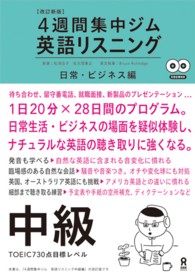基本説明
Offers practical collection and analysis tools, templates and methods, and ways to think about data.
Full Description
Collect multiple forms of data and connect data to improved student achievement!
Are you looking for new ways to use data in the decision-making process? Are you seeking tools that provide better flow-through from data to improved student achievement? Have you ever considered including students in the data-to-improvement cycle? Schools recognize that data is an essential decision-making tool, but it requires teamwork and reflection to reap the maximum benefits. This guidebook offers practical collection and analysis methods and templates as well as tips for building trust and working together.
The Data Guidebook for Teachers and Leaders accentuates the importance of data collection of multiple types, not just from standardized tests, and analysis within any educational setting. In addition to addressing the practical aspects of data usage, the author presents innovative ideas for
Introducing students to the data analysis cycle
Helping students learn how data impacts student achievement
Sharing day-to-day data within departments and schools to improve weekly test scores
Making data and results accessible to all team members
Data becomes a dynamic tool for change when you learn how to incorporate it into your continuous improvement process.
Contents
List of Figures
Preface
About the Author
1. Data-Based Decision Making and the Improvement Process
What Do the Experts Say?
The Process
The Improvement Cycle
Closing Thoughts
2. Data Collection
What Should Be Collected?
Creating a Balance
Must-Have Data
Tools: The Three "T's"
Closing Thoughts
3. Delving Into the Data
Getting a Closer Look at Data
Defining a Purpose
Creating an Atmosphere of Acceptance
Planning and Implementing the Data Delve
Closing Thoughts
4. Standardized and State Test Data
Reporting Data
Comparing Response Types
Item Analysis
Promoting Analysis and Discussion
Closing Thoughts
5. Using District Assessments
District Assessments
Collecting the Data
Why Collect and Share?
Closing Thoughts
6. Rubrics: Data Use and Organization
Gaining a Common Understanding: Holistic and Analytical Rubrics
Gathering Individual Student Data From Rubrics
Reporting Results
Communicating With Students
Evaluating Group Data From Rubrics
Closing Thoughts
7. Classroom Assessment Data
The Purpose of Collection
Grade Book Highlighting
Item Analysis
Classroom Disaggregations
Rubric Results
A Systematic View of Classroom Analysis
Daily Reflection
Closing Thoughts
8. Students and Data
Feedback
Reflection
Charts and Graphs
Closing Thoughts
9. Experiencing Success
Generate Interest
Make Data a Habit
Involve Others
Promote the Cycle
Create an Expectation
Expect Change
Provide Support
Celebrate Success
Bibliography
Index








